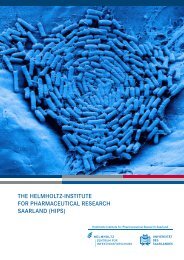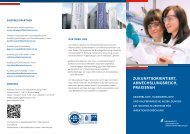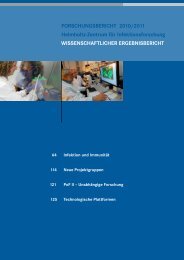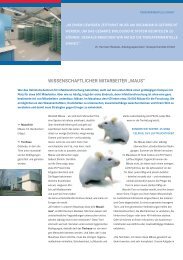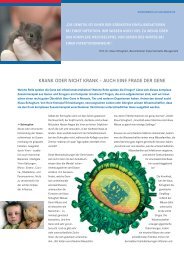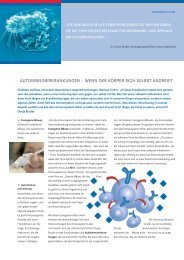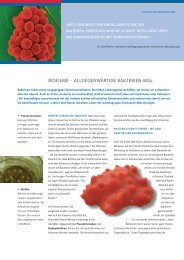Research Report 2010 2011 - Helmholtz-Zentrum für ...
Research Report 2010 2011 - Helmholtz-Zentrum für ...
Research Report 2010 2011 - Helmholtz-Zentrum für ...
Create successful ePaper yourself
Turn your PDF publications into a flip-book with our unique Google optimized e-Paper software.
26 RESEARCH REVIEWS | Frontier Runners of Hepatitis C Virus<br />
with higher doses of prednisolone and other steroids<br />
increased HCV infectivity. By means of time-kinetic<br />
experiments, we were able to prove that HCV under<br />
treatment of steroids can penetrate the liver cells more<br />
quickly. With the aid of retroviral pseudotypes, we could<br />
show that the increase in infectiousness was specific for<br />
HCV. Further mechanistic studies revealed that prednisolone<br />
treatment increased the mRNA and the protein expression<br />
of SR-BI and occludin, two proteins that are essential<br />
components of the HCV receptor complex.<br />
It was possible to ablate this steroid effect through the use<br />
of the glucocorticoid receptor inhibitor RU-486, which<br />
indicates that this signalling cascade is responsible for the<br />
influence on the receptor expression and the HCV cell entry.<br />
Moreover, we noted that prednisolone not only facilitated<br />
virus cell entry and spread in the human hepatoma-cell-line<br />
Huh-7.5: the incubation with prednisolone also increased<br />
viral dissemination in dimethyl-sulphoxide-differentiated<br />
liver cells and primary human hepatocytes. This result<br />
correlates with the clinical experience in the patient:<br />
Various clinical studies had reported that administration of<br />
high dosages of steroids, for example in the context of acute<br />
organ rejection treatment, was associated with increased<br />
viral load and augmented liver inflammation 8 . Correspondingly,<br />
avoidance of highly-dosed steroids could contribute to<br />
an improvement in clinical course after HCV-induced liver<br />
transplant.<br />
Hepatitis C – not only in the liver? To date research on<br />
HCV has been primarily focussed on the liver – an obvious<br />
focus, since the symptoms can be attributed predominantly<br />
to damage of this organ. Upon more precise investigation<br />
however, one can see that infection with HCV generates a<br />
series of other symptoms as well, and these symptoms are<br />
not necessarily in direct relation to the liver infection.<br />
Patients with a chronic HCV infection often times present<br />
with various nervous system-associated symptoms. Chronic<br />
fatigue syndrome, depression and cognitive disorders<br />
frequently appear. It is however unclear whether these<br />
symptoms can be attributed to a direct HCV replication in<br />
the brain and the peripheral neuronal cells, or to indirect<br />
effects upon the central and peripheral nervous system. For<br />
this reason we investigated whether host cells from these<br />
tissues – among them human neuroblastoma and glioblastoma<br />
cell-lines and microglial cells – are susceptible to HCV<br />
infection and can propagate the virus 4 . In this context we<br />
identified the human peripheral neuroblastoma cell-line<br />
SKNMC, which expresses all four essential HCV-entry<br />
factors and was susceptible to cell entry by our HCV<br />
pseudo-particles (HCVpp). Our investigations did however<br />
show as well that the virus cannot efficiently propagate in<br />
these cells. Nevertheless, our results point to the fact that<br />
HCV can for all intents and purposes penetrate into<br />
non-hepatic cell types. These interactions may in turn<br />
influence the development of the disease and particularly<br />
extra-hepatic disease manifestations.<br />
Small molecules up against an unsolved problem The<br />
options available for therapy against HCV are currently still<br />
insufficient. Although a series of direct antiviral substances<br />
are in clinical development, undesirable side-effects,<br />
resistance development and genotype-specific antiviral<br />
activity still pose substantial challenges. For this reason, the<br />
on-going search for appropriate therapy measures continues.<br />
The focus is now on combinations of well-tolerated active<br />
compounds that act at different steps within the HCV<br />
replication cycle. In this manner, a combination therapy<br />
with drugs acting via distinct mode of action should prevent<br />
rapid development of viral resistance.<br />
In order to identify substances that disturb the various<br />
steps in the HCV replication cycle, we have developed a new<br />
dual-reporter-gene assay, and adapted it in collaboration<br />
with scientists at the HZI to a high-through-put-screening<br />
procedure (Figure 4). This system encompasses the entire<br />
HCV life-cycle and, therefore, enables identification of<br />
inhibitors against each individual step in viral propagation 10 .<br />
The assay is based on an HCV reporter virus that carries a<br />
gene for a luciferase-enzyme of the firefly (F-Luc; firefly<br />
luciferase). The host cells, which are used for propagation of<br />
HCV, were equally furnished by us with a luciferase gene<br />
from the deep-sea crab gaussia (G-Luc; gaussia luciferase).<br />
Since the two luciferase enzymes use different substrates<br />
and do not influence one another, propagation of the HCV<br />
and the vitality of the cells are simultaneously determined.<br />
In this manner we are able to differentiate between<br />
antiviral molecules and inhibitors of cell growth and<br />
cytotoxic compounds, i.e. separate the wheat from the chaff.<br />
Subsequently we validated the system with the aid of<br />
known HCV inhibitors for cell entry, replication and virus



